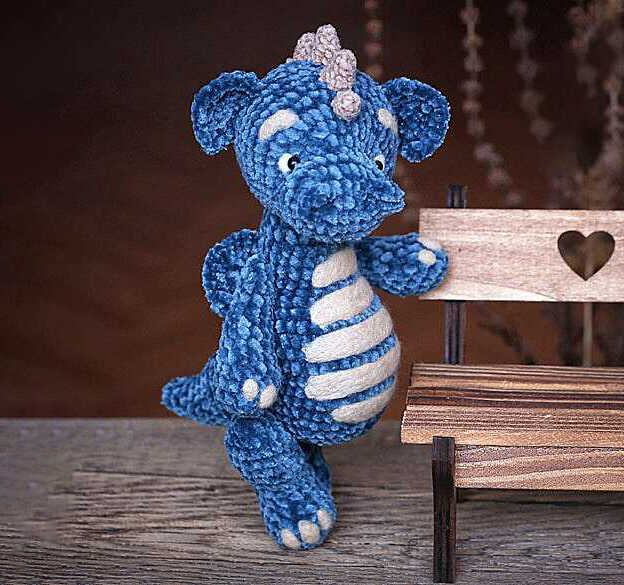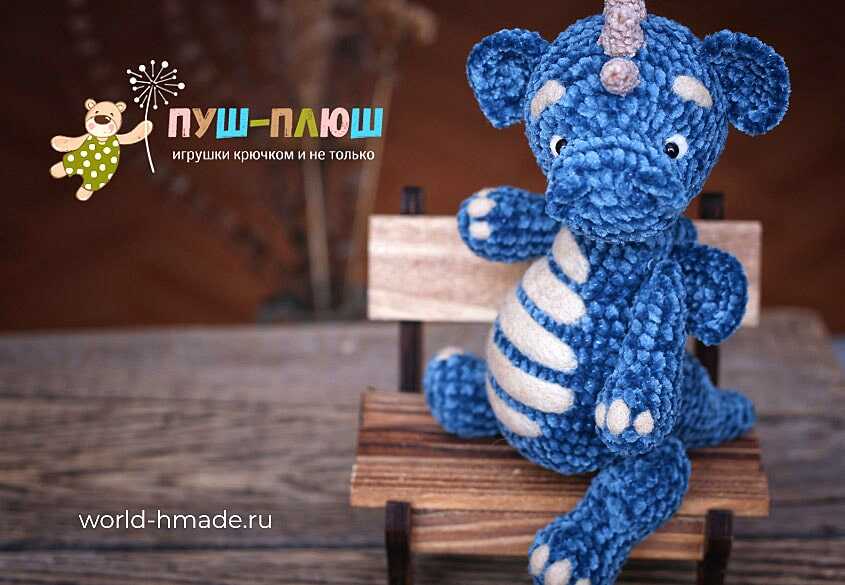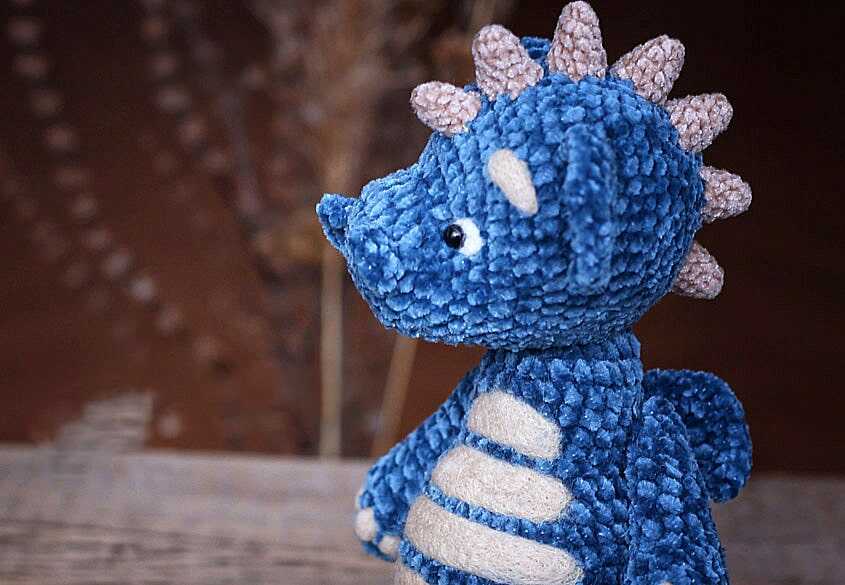Hello…
One of the free amigurumi crochet patterns we will share today is the amigurumi velvet dragon. You can learn how to crochet these dragon using the free amigurumi pattern.

Amigurumi cats, amigurumi dolls, amigurumi dogs, amigurumi unicorns, amigurumi lambs, amigurumi dinosaurs, amigurumi foxes, amigurumi bears, amigurumi giraffes, amigurumi pigs, amigurumi birds, amigurumi penguins, amigurumi panda, amigurumi llama, amigurumi bunny, amigurumi clowns, amigurumi elephants, amigurumi hippos, amigurumi monkeys will not be difficult for you…
Materials
• Yarn. I knitted the main parts of the toy from plush yarn “Plush Light” with a very unusual color name “overflow of petroleum”. For knitting horns on my head (unfortunately, I don’t know what these growths on a dragon’s head are called correctly) I used a thin bobbin velor.
• Crochet hook. For knitting with Plush Light yarn, I used hook No. 2, for velor – No. 1.25.
• Filler for soft toys.
• Cotter pins, if you decide to attach the parts of the toy using cotter pins.
• Eyes. I used eyes for toys with a diameter of 5 mm.
• Wool for felting beige and white.
• Needle for felting thin twisted No. 40.
• Threads in tone yarn for sewing details.
• A long needle for sewing soft toys.
Abbreviations:
ch = chain
sc = single crochet
st = stitch
inc = increase (2 sc in one st)
dec = decrease (2 sc together)
dc inc = 2 dc in one st
sl st = slip stitch

AMIGURUMI VELVET DRAGON FREE PATTERN
Head
1 row: we collect a chain of 5 air loops (hereinafter – ch). Next, we begin to tie the chain, starting with the second from the loop hook. 1 increase, 2 single crochet (hereinafter – sc), 2 increments in one loop at the end of the chain. Then we knit on the other side of the chain:
2 sc, 1 increase (12).
2 row: repeat (1 increase, 1 sc) 6 times (18).
3 row: repeat (1 increase, 2 sc) 6 times (24).
4-5 rows: we knit 1 sc in each loop of the previous row (24).
6 row: we knit 1 sc to align the knitting, then we knit 3 sc, 6 increments, 15 sc (30).
The location of the increase on the dragon’s face is shown in the photo.
7 row: 3 sc, (1 increase, 1 sc) – repeat 6 times, 15 sc (36).
8 row: (5 sc, 1 increase) – repeat 6 times (42).
9 row: (6 sc, 1 increase) – 6 times (48).
10-14 rows: we knit 1 sc in each loop of the previous row (48).
15 row: repeat (6 sc, decrease) 6 times (42).
16 row: repeat (5 sc, decrease) 6 times (36).
17 row: repeat (4 sc, decrease) 6 times (30).
We fill the dragon’s head with filler in the area of the muzzle. We fix the cotter pin between 12 and 13 rows.
18 row: repeat (3 sc, decrease) 6 times (24).
19 row: repeat (2 sc, decrease) 6 times (18).
We stuff the connected part of the dragon’s head.
20 row: repeat (1 sc, decrease) 6 times (12).
21 row: decrease until the hole is completely closed.
Knitting the nostrils for the dragon (2 parts).
We type 4 ch and, starting from the second loop from the hook, we knit 3 sc on one side of the chain.
Muzzle
After we have tied the head and nostrils for the dragon, we can proceed to the design of the muzzle of the toy. To begin, let’s choose the position of the eye. This is a very important point when creating a toy. I will use 5 mm diameter sewing eyes with an eyelet. The shape of these eyes resemble mushrooms.
Along with sewing the eye, we will make the muzzle tightening.
Choosing the position of the eye with the needles, it is better to place them a little further apart, since when pulling together they will slightly change the position, become closer.
We fix the thread in the cotter pin area and put the needle in the place where the eye will be located. It is better for this purpose to use a long needle for sewing soft toys.
We put the eye on the needle, then again insert the needle into the head and bring it to the area of attachment of the second eye.
We put our eyes on the needle and pierce the head of the toy again, returning to the first eye. We are tightening. Repeat this operation several times.
Arms
1st row: dial 2 ch and knit 6 sc into the second loop from the hook (6).
2 row: repeat (1 increase) 6 times (12).
3 row: repeat (3 sc, 1 increase) 3 times (15).
4-5 rows: we knit 1 sc in each loop of the previous row (15).
6 row: 3 decreases, 9 sc (12).
7-8 rows: we knit 1 sc in each loop of the previous row (12).
9 row: 1 sc, 2 decreases, 7 sc (10).
10-11 rows: we knit 1 sc in each loop of the previous row (10).
After knitting 11 rows, we fill the lower part of the dragon’s paw. We will not stuff the upper part of the foot.
12 row: we knit 1 sc in each loop of the previous row (10).
We fix the cotter pin between 11 and 12 rows. Note that where we knitted the decreases – this is the front of the knitted dragon’s paw.
13 row: we knit decreases until the hole is completely closed.
Legs
1st row: dial 2 ch and knit 6 sc into the second loop from the hook (6).
2 row: repeat (1 increase) 6 times (12).
3 row: repeat (1 increase, 1 sc) 6 times (18).
4 row: we knit 1 sc in each loop of the previous row (18).
5 row: 7 sc, 2 decrease, 7 sc (16).
6 row: 6 sc, 2 decreases, 6 sc (14).
7-8 rows: we knit 1 sc in each loop of the previous row (14).
9 row: 6 sc, 2 increments, 6 sc (16).
10 row: 7 sc, 2 increments, 7 sc (18).
11-13 rows: we knit 1 sc in each loop of the previous row (18).
Stuff the connected part of the foot.
14 row: (1 sc, 1 decrease) – repeat 6 times (12).
We stuff the part, fix the cotter pin between 13 and 14 rows.
15 row: decrease until the hole is completely closed.
Torso
1st row: dial 2 ch and knit 6 sc into the second loop from the hook (6).
2 row: repeat (1 increase) 6 times (12).
3 row: repeat (1 increase, 1 sc) 6 times (18).
4th row: repeat (1 increase, 2 sc) 6 times (24).
5-9 rows: we knit 1 sc in each loop of the previous row (24).
10 row: repeat (1 increase, 3 sc) 6 times (30).
11 row: repeat (1 increase, 4 sc) 6 times (36).
We fix the upper legs of the dragon between the 7th and 8th rows.
12 row: 12 sc, (1 sc, 1 increase) – repeat 6 times, 12 sc (42).
13-14 rows: we knit 1 sc in each loop of the previous row (42).
15 row: repeat (1 increase, 4 sc) 6 times (48).
16-20 rows: we knit 1 sc in each loop of the previous row (48).
21 row: repeat (6 sc, 1 decrease) 6 times (42).
22 row: repeat (5 sc, 1 decrease) 6 times (36).
23 row: repeat (4 sc, 1 decrease) 6 times (30).
24 row: repeat (3 sc, 1 decrease) 6 times (24).
We fix the legs of a knitted dragon between 22 and 23 rows.
25 row: repeat (2 sc, 1 decrease) 6 times (18).
26 row: repeat (1 sc, 1 decrease) 6 times (12).
27 row: we crochet a decrease until the hole is completely closed.

Tail
1st row: dial 2 ch and knit 6 sc into the second loop from the hook (6).
2 row: repeat (1 sc, 1 increase) 3 times (9).
3 row: we knit 1 sc in each loop of the previous row (9).
4th row: repeat (2 sc, 1 increase) 3 times (12).
5 row: we knit 1 sc in each loop of the previous row (12).
6 row: 4 sc, 4 increases, 4 sc (16).
7 row: we knit 1 sc in each loop of the previous row (16).
8 row: 4 sc, (1 sc, 1 increase) – repeat 4 times, 4 sc (20).
9-10 rows: we knit 1 sc in each loop of the previous row (20).
11 row: 4 sc, (2 sc, 1 increase) – repeat 4 times, 4 sc (24).
12 row: we knit 1 sc in each loop of the previous row (24).
We knit the connecting column in the last loop and finish knitting the tail for the dragon.
Horns
We will knit horns (or growths on the dragon’s head) from bobbin velor (it is thinner than plush yarn) using a hook No. 1.25.
The very first horn on the dragon’s head, which is located on the forehead, is slightly smaller than the rest. Such a small horn, we need to tie only one. It fits in this way:
1st row: dial 2 ch and knit 6 sc into the second loop from the hook (6).
2 row: repeat (1 sc, 1 increase) 3 times (9).
3 row: we knit 1 sc in each loop of the previous row (9).
4th row: repeat (2 sc, 1 increase) 3 times (12).
Big horns 6 pieces. In order to connect them, it is necessary to tie a small horn (all 4 rows), and then, without tearing off the working thread, proceed to knitting the 5th row:
5 row: repeat (3 sc, 1 increase) 3 times (15).
Sewing horns to the dragon’s head, I advise this: firstly, the horns must be secured with a pin so that the part of the toy does not accidentally shift during sewing. And secondly, for sewing on these small parts it is better to use a regular thread in tone yarn horns and a needle for sewing. Sewing details with plush or velor yarn is extremely difficult.
Wings and Ears
The wings and ears for the dragon fit in one pattern.
1 row: we collect 6 ch Starting from the second loop from the hook, we knit: 2 sc, 3 sc in one loop, 2 sc (7). Expand knitting.
2 row: 3 sc, 3 sc in one loop, 3 sc (9). Expand knitting.
3 row: 4 sc, 3 sc in one loop, 4 sc (11). Finish knitting parts.
Claws on paws, stripes on the tummy, eyebrows and eyes of the dragon are made using the technique of dry felting.
Source:world-hmade.ru
